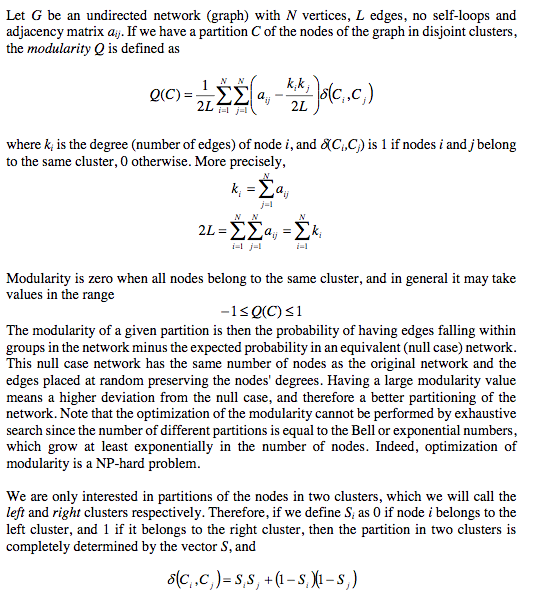Implementation of a genetic algorithm (GA) for the clustering of the nodes of a graph. Done for the Neural and Evolutionary Computation subject.
Implementation of a genetic algorithm(GA) for the clustering of the nodes of a graph, by means of the optimization of modularity.
Given the network G, any vector S may be seen as the chromosome corresponding to a partition in two clusters, and the fitness is related to its modularity Q(S).
The objective is the implementation of a genetic algorithm to obtain the partition which maximizes modularity.
Modularity cannot be used directly as the fitness since it may take negative values, and also the difference in modularity of good partitions may be very small. You should define a transformation of modularity into an adequate positivefitness function, use the rank, or try with robust selection methods.
- Input: a network in Pajek format (*.net | More info in http://pajek.imfm.si/)
- Output: the highest modularity partition found, in Pajek format (*.clu), and its corresponding value of modularity
Try different variants of the genetic algorithm and of their corresponding parameters, for instance:
- Fitness function
- Selection schemes: proportional (roulette-wheel), truncation, ranking, tournament, fitness uniform (FUSS), etc.
- Crossover: one-point crossover, two-point crossover, uniform crossover, etc.
- Mutation
- Elitism
This is the “real” partition of the Zachary Karate Club network, as a reference for a good partition in two communities (not necessarily the one with largest modularity).
Copyright 2018 Francisco Javier Rodrigo Ginés
This program is free software: you can redistribute it and/or modify it under the terms of the GNU General Public License as published by the Free Software Foundation, either version 3 of the License, or (at your option) any later version.
This program is distributed in the hope that it will be useful, but WITHOUT ANY WARRANTY; without even the implied warranty of MERCHANTABILITY or FITNESS FOR A PARTICULAR PURPOSE. See the GNU General Public License for more details.
You should have received a copy of the GNU General Public License along with this program. If not, see http://www.gnu.org/licenses/.

